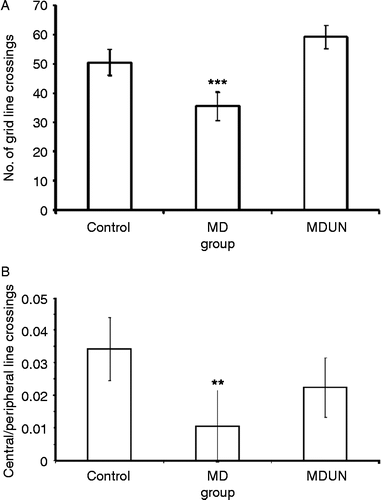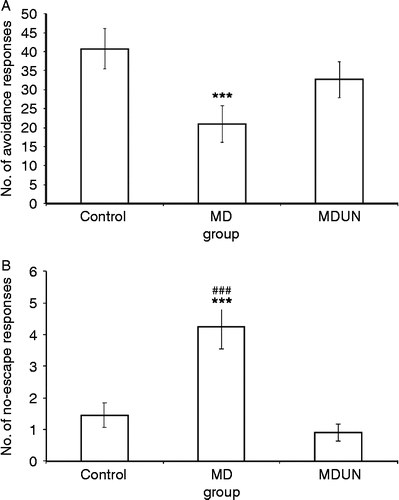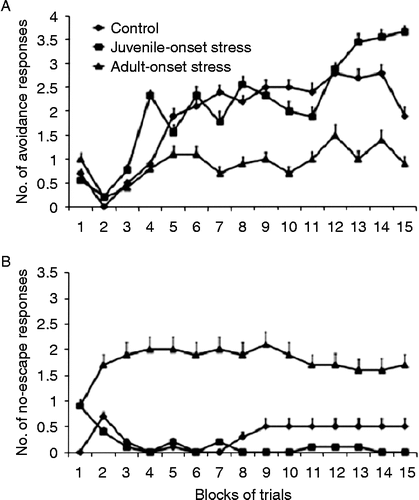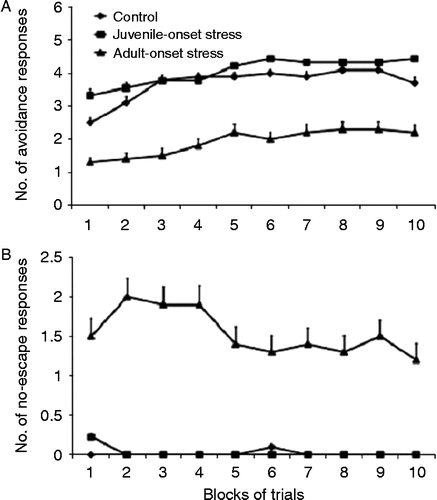Figures & data
Figure 2. Activity in the open field (Experiment A). (A) Number of times the rats crossed grid lines on the floor of the open field. A larger number indicates less anxiety. (B) Ratio of central to peripheral line crossings in the open field. A higher ratio indicates less anxiety. Three groups of adult rats were tested: control, maternal deprivation (MD) and maternal deprivation followed by juvenile-onset uncontrollable chronic stress (MDUN). ** 0.01, *** 0.001.

Figure 3. The number of (A) avoidance responses and (B) no-escape responses in the shuttle box to the conditioned stimulus (tone) that immediately preceded a 10-s 0.8-mA foot shock during 20 blocks of five trials in the two-way shuttle avoidance box in Experiment A. Three groups of adult rats were tested: control, maternal deprivation (MD) and maternal deprivation followed by juvenile-onset uncontrollable chronic stress (MDUN). In figure (A), asterisks (***) indicate that the MD group differed from the control group, p = 0.001. In figure (B), asterisks (***) indicate that the MD group differed from the MDUN and hashes (###) indicate the control groups, p = 0.001.

Figure 4. Learning in the water maze (Experiment A). The time (s) required for the control, maternal deprivation (MD) and maternal deprivation followed by juvenile-onset uncontrollable chronic stress (MDUN) groups to find a hidden platform submerged at a fixed location. Data for each of the 12 trials (T1–T12) are given.

Figure 5. Memory of a learned route through the modified complex maze (Experiment A). Mean percentage of correct door openings (traverses) by the control, MD and MD followed by juvenile-onset uncontrollable chronic stress (MDUN) groups in the modified complex maze. Data for the five trials conducted during the test phase of the experiment are given. Asterisks (**) indicate that the MD and MDUN groups differ from the control group, p < 0.01.

Figure 6. Number of avoidance and no-escape responses during training in the shuttle box (Experiment B). Rats that were exposed to stress during adulthood (the adult-onset stress group) and then trained in a two-way shuttle avoidance task made (A) fewer avoidance responses and (B) more no-escape responses during training than rats whose exposure to the same stress protocol began during juvenility (the juvenile-onset stress group) and control animals. The learning phase involved 75 sessions in the apparatus (analysed as 15 blocks of five trials). A group effect was observed both for the number of avoidance and the number of no-escape responses, with the adult-onset stress group making fewer avoidance responses than the control (p < 0.01) and juvenile-onset stress (p < 0.05) groups.

Figure 7. Number of avoidance and no-escape responses during memory testing in the shuttle box (Experiment B). Fifteen days after the learning session, the groups underwent a memory retention test consisting of 10 blocks of five trials in the two-way shuttle avoidance task. The memory retention test revealed that (A) the number of avoidance responses did not differ significantly between the juvenile-onset and adult-onset stress groups. However, (B) there were significant differences between the number of no-escape responses made by the groups. The adult-onset stress group made more no-escape responses than the control (p < 0.05) and juvenile-onset stress groups (p < 0.05). The number of no-escape responses by the juvenile-onset stress and control groups did not differ significantly.


